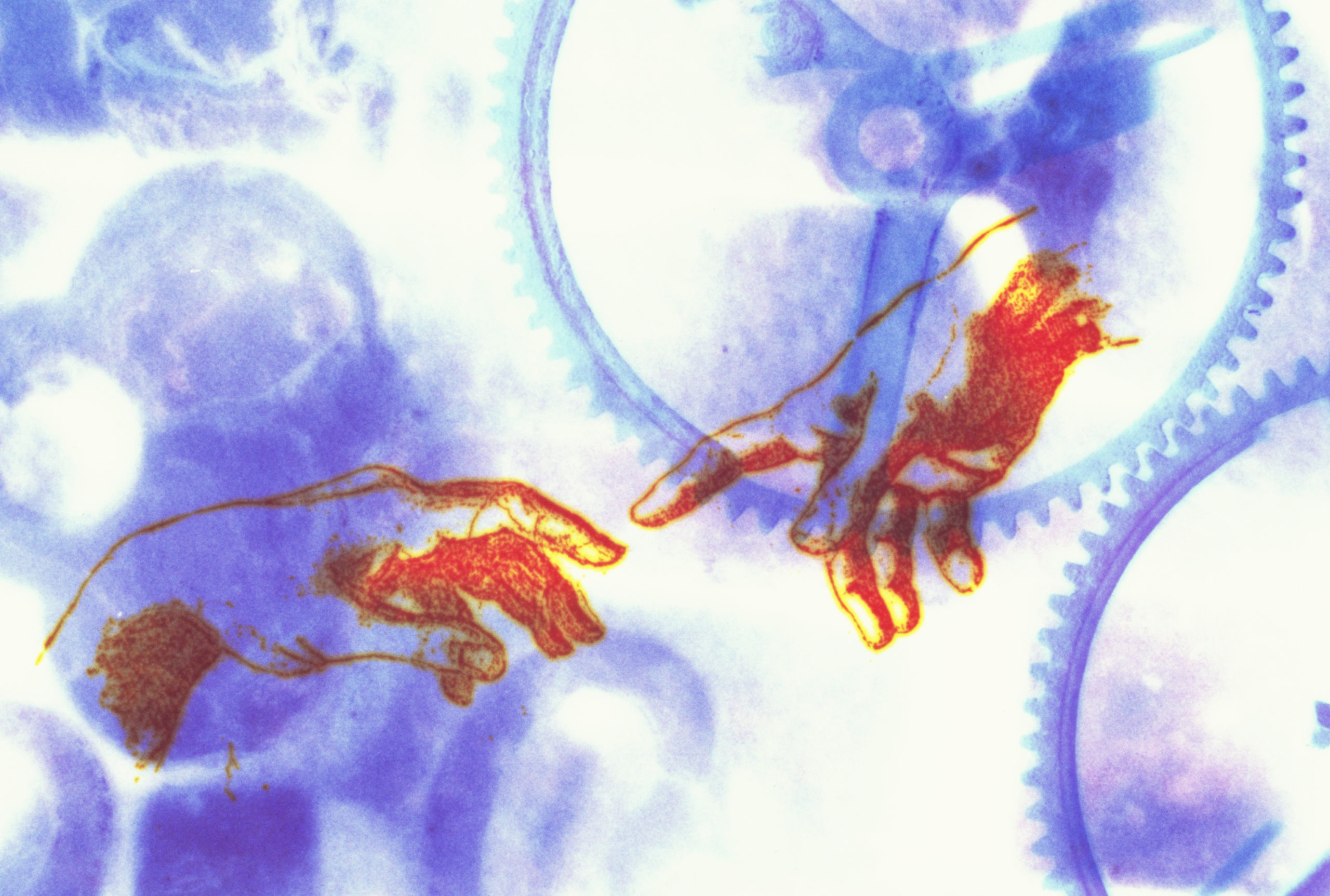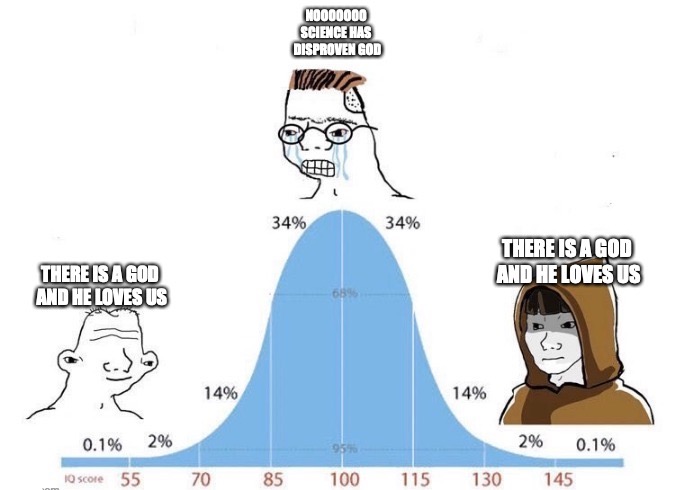When the church falls captive to woke ideology, secular truth-tellers win the day.
God’s Footprints

Science makes faith plausible, not impossible.
Andrew Klavan’s reference to the popular Bell Curve meme calls to my mind one particularly provocative version of that meme, in which the three figures representing the different levels of insight and intelligence address the relationship between science and belief in God.
The dullard on the left-hand tail of the curve says, “don’t listen to science, all the answers come from God.” The representative of conventional wisdom sitting at the top of the curve says, “God isn’t real. You should trust the science.” But then, as in all versions of the meme, a twist occurs. The jedi-savant figure at the extreme right-hand tail of the curve reaffirms the existence of God because of, not in spite of, what science has discovered.
Something like this progression has played out in Western science and culture over the last century and a half. Proponents of fundamentalist and anti-intellectual expressions of religion often expressed distrust of science for its alleged atheistic tendencies. On the other hand, popular spokesmen for science, such as Richard Dawkins, Bill Nye, and Lawrence Krauss, have told the public that science does, indeed, render belief in God untenable. Consequently, they have helped to establish the conventional wisdom that science shows “God isn’t real” or belief in God is “a delusion,” as Dawkins put it.
But as I show in a new book, Return of the God Hypothesis, several major scientific discoveries over the last century have quietly cast doubt on these confident atheistic presumptions. Whereas Richard Dawkins claims that “the universe we observe has precisely the properties we should observe if, at bottom, there is no purpose, no design…nothing but blind pitiless indifference,” science itself now tells a decidedly different story. Indeed, at least three major discoveries about the origin of the universe and life contradict the expectations of the scientific atheists and materialists who have long assumed that everything we see in the universe can be explained as the result of purely mindless, materialistic processes. Arguably, these discoveries also point in a distinctly God-friendly direction.
First, astronomers and cosmologists have discovered that the physical universe had a beginning, contrary to the expectations of scientific materialists who long portrayed the universe as eternal and self-existent and, therefore, in no need of an external creator.
This evidence for a beginning—from numerous discoveries in observational astronomy and developments in theoretical physics—has instead confirmed the expectations of traditional theists. As Nobel laureate Arno Penzias, who helped make a key discovery establishing a cosmic beginning, later observed, “The best data we have are exactly what I would have predicted, had I nothing to go on but the first five books of Moses…and the Bible as a whole.”
Discoveries from physics about the structure of the universe reinforce such a theistic conclusion. Since the 1960s, physicists have determined that the fundamental physical laws and parameters of our universe have been finely tuned, against all odds and for no underlying physical reason, to make our universe capable of hosting life. Even slight alterations in the values of many independent factors—such as the strength of gravitational and electromagnetic attraction, the masses of elementary particles, and the initial arrangement of matter and energy in the universe—would have rendered life impossible. Essentially, we live in a kind of “Goldilocks universe,” or what Australian physicist Luke Barnes calls an extremely “Fortunate Universe.”
Not surprisingly, many physicists have concluded that this improbable fine tuning for life points to a cosmic “fine-tuner.” As former Cambridge astrophysicist Sir Fred Hoyle argued: “A common sense interpretation of the data suggests that a super-intellect has monkeyed with physics” to make life possible. Or as British physicist Paul Davies exclaimed, “the impression of design is overwhelming.”
Third, molecular biology has revealed the presence in living cells of an exquisite world of informational nano-technology—digital code in DNA and RNA; tiny, intricately-constructed molecular machines, a complex information storage, transmission, and processing system that resembles, but vastly exceeds, our own digital high technology. Biotechnologist Leroy Hood has noted that DNA contains “digital code.” But this would seem to imply that a Master Coder had a hand in the origin of life. At the very least, the discoveries of modern biology are not what anyone would have expected as the result of blind materialistic processes or “pitiless indifference.” Even Dawkins may have conceded as much when he recently confessed to being knocked “sideways with wonder at the miniaturized intricacy of the data-processing machinery in the living cell.”
All this implies that science itself increasingly supports what Klavan asserts throughout his essay—namely, that “there is a God” and “Creation speaks his nature.” Indeed, we might amplify the theme of Klavan’s essay (and the Bell Curve meme about science and God) by quoting the famed physicist Werner Heisenberg, who said: “The first gulp from the glass of natural sciences will turn you into an atheist, but at the bottom of the glass God is waiting for you.”
Klavan’s insight about the relationship between dystopias and atheism (or scientific materialism) is also perceptive. The fictional dystopias of Brave New World, The Giver, The Matrix—and I would add, C.S. Lewis’s That Hideous Strength—invariably depict future states where men and women are treated as purely material entities devoid of moral impulse and spiritual longing. In such dystopian societies, a reductionist and materialistic concept of human beings ensures that something important—love, freedom, human rights, justice, dignity, faith—is always horrifically omitted or suppressed by those in control.
The totalitarian dystopias of the 20th century replicated this pattern, but in real life. National Socialism and Soviet Marxism both cited science as a justification for their materialistic ideologies and utopian visions but succeeded only in creating hell on Earth—and, indeed, in perpetrating genocide. All of this supports Klavan’s other key contention: “We need not abandon the scientific knowledge of modernity, but we must subjugate it to the needs of our humanity rather than allow its fleshless, sexless, motherless materialism to turn us into itself.”
The American Mind presents a range of perspectives. Views are writers’ own and do not necessarily represent those of The Claremont Institute.
The American Mind is a publication of the Claremont Institute, a non-profit 501(c)(3) organization, dedicated to restoring the principles of the American Founding to their rightful, preeminent authority in our national life. Interested in supporting our work? Gifts to the Claremont Institute are tax-deductible.
The Secret Knowledge is the antidote to lostness.
An alternative to dystopia.



